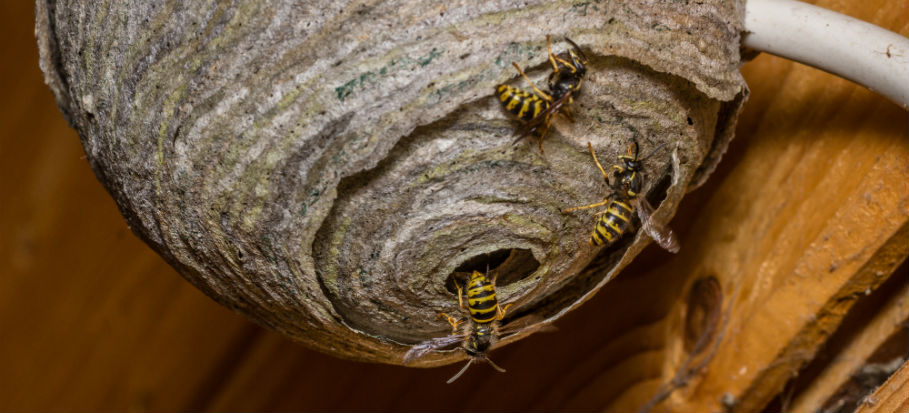
What does a Wasp Nest look like?
You’ll know if you’ve got a wasp nest nearby If you notice a large number of wasps that seem to be focused in one particular area.
There are over 7000 species of wasps living in the UK, and unlike bees’ wasps are a very unwelcome pest in any garden or home, this tends to be because they are much more aggressive then bees and when they attack they are able to sting multiple times. Wasps won’t hesitate to attack anything they deem a threat to their nest.
Although wasps don’t usually go around attacking humans unprovoked, when wasp nests becomes overcrowded and the summer temperatures start to soar the wasps can become agitated and start to sting with little provocation.
By the time autumn comes around wasps can become even more aggressive, this is because they have completed their work and spend, they rest of their time devouring fermented fruit which results in the wasps becoming drunk. Drunken wasps with nothing to do is a bad combination! This causes the wasps to go on a drunken rampage and will attack anything in their way even when it means putting their own lives at risk.
How Do You Find A Wasp Nest?
Common places for wasps to build their nests are, inside lofts, in trees, in sheds, garages and the edge of the roof top. Less common but still possible some nests can be found inside your home, usually in unused rooms and even wardrobes!
It is important that you locate wasp nests as soon as possible to ensure the safety of both you and your family. To find the nest you need to spend a bit of time observing the wasps and their flight patterns. You should notice that they are coming and going from one particular spot, if you follow the flight path where you see the wasp activity then you should soon see the wasp nest.
At this point when you have located the nest it is not recommended that you approach it, instead call in a local pest control professional the will be able to come and assess the nest and go through treatment and or removal options with you. If you or someone in your household has a known allergy to wasp or bee stings then under no circumstance should you try and approach the wasp nest, you should call a pest control professional immediately and stay indoors to eliminate the risk of you or someone you care about being stung and falling ill.
How Do You Identify What Kind Of Nest It Is?
There are different features within the nests that will help you determine what species of wasp you are dealing with, here are a few:
- If you see the wasps’ nest on a building, in a tree or the wasps are coming from a hole in the ground then it is likely yellow jackets that you are dealing with. A yellow jacket wasp nest can contain up to two thousand wasps!
- If you see a nest that is football sized, round in shape, slightly pointed at the bottom and has a smooth paper like appearance with one large opening then it is likely a hornet’s nest.
- If the nest you see is made from tightly packed yellow hexagonal comb layers and has a waxy appearance, then it is likely that the nest you see is actually a honeybee hive. Honeybees are rarely aggressive and are a protected species as they are important to the environment.
If you find that you have honeybees, then by law they can not be treated. However, if you contact your local pest control professional, they should be able to give you advice and information on what to do. In some cases, you can contact a local beekeeper who will be more that happy to come and move then honeybees’ nest and add it to their colony.
What To Do If You Find Wasp Nests
Trying to remove a wasp nest yourself can be extremely dangerous so it is never recommended that you attempt this particularly if the nest is in a difficult to access area.
If you are having problems with a wasp nest or require our wasp nest removal service in Bristol, then contact Advance Pest Control Bristol today – 07771503107
You can also find out more information about wasps on our wasp control page.
Recent Comments